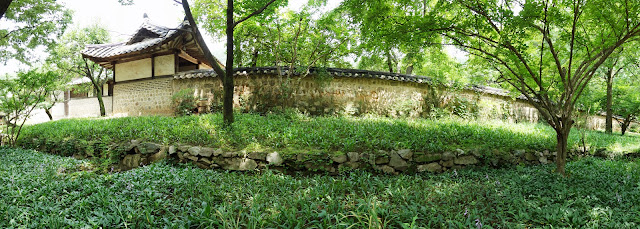We headed to Dajeon bus terminal complex early to get catch a bus. The journey would take about an hour an a half.
Bus tickets
Everyone with their morning coffee.
The seats were nice and comfortable. We had loads of leg room and the seats were leather.
Once we got to Yongin it was just a short taxi trip to the folk village.
Finally, we arrived at the village. It already looked different to last time. The trees on the mountain were green, rather than dead sticks poking out of the ground.
Tickets into the village.
Koreans love their big pots. They use them to store Kimchi, soy sauce, red pepper paste, soybean paste and chilly paste.
This is a kind of prayer/wishing rock. You write your prayer/wish on a piece of paper and tie it onto the string. The paper is burnt along with sheaves of rice on the first full moon of the new year.
These are guards to protect the gateway to the village.
This is the village prayer tree. All Korean villages had one.
This is a dutiful son's monument. Good sons would build these places to honor their fathers.
Some crop fields. They have changed a lot since I was here last.
6 months ago...
Another wishing tree
Flowers lining the road through the village.
Traditional kitchen.
Sitting on the porch of a South Korean hut. North Korean huts didn't have outside sitting areas because the seasons are much colder.
On the wall here is a winnowing basket for bed-wetters. If a child wet the bed the parents would send their children to their neighbours with a winnowing basket on their head to ask for salt. The goal was to embarrass the child into not wetting the bed anymore.
An old grain mill stone.
This was interesting. She was spinning silk. I really should have taken a video. It was interesting watching it effortlessly unravel off the silk worm cocoons and get spun into silk.
We then wandered through the village back to the food court to find some lunch.
There were a few restaurants to choose from. We picked on that offered Bibimbap in a hot bowl and had Bulgogi on the menu and ordered our lunch.
This is Bulgogi and one of my favorites. Sometimes it can be hot (spicy hot), but this one wasn't.
This is Bibimbap. You can get it a couple of ways. It can come in a plain old bowl with a fried egg on the top, or it can come in a super hot bowl with a raw egg on the top and as you mix everything together the egg cooks. This is my preferred way to eat Bibimbap. I think it is a million times better.
After lunch it started raining, but we continued on to explore the rest of the village.
When a child was born in a Korean home the family would hang pepper from the doorway if it was a boy, and charcoal if it was a girl. The pine needles are to stop ghosts from coming into the home and the white paper is so you can see the string at night and don't walk into it.
Blacksmith hut.
Wheeeeeee :)
This was a naughty place in ancient times. During the day grain would be milled here, but a night young boys and girls would meet here and... err... well, you get the picture.
Sadly, the horse riding stunt show had been canceled due to the rain so we jumped on a bus and headed back to Daejeon.





No comments:
Post a Comment